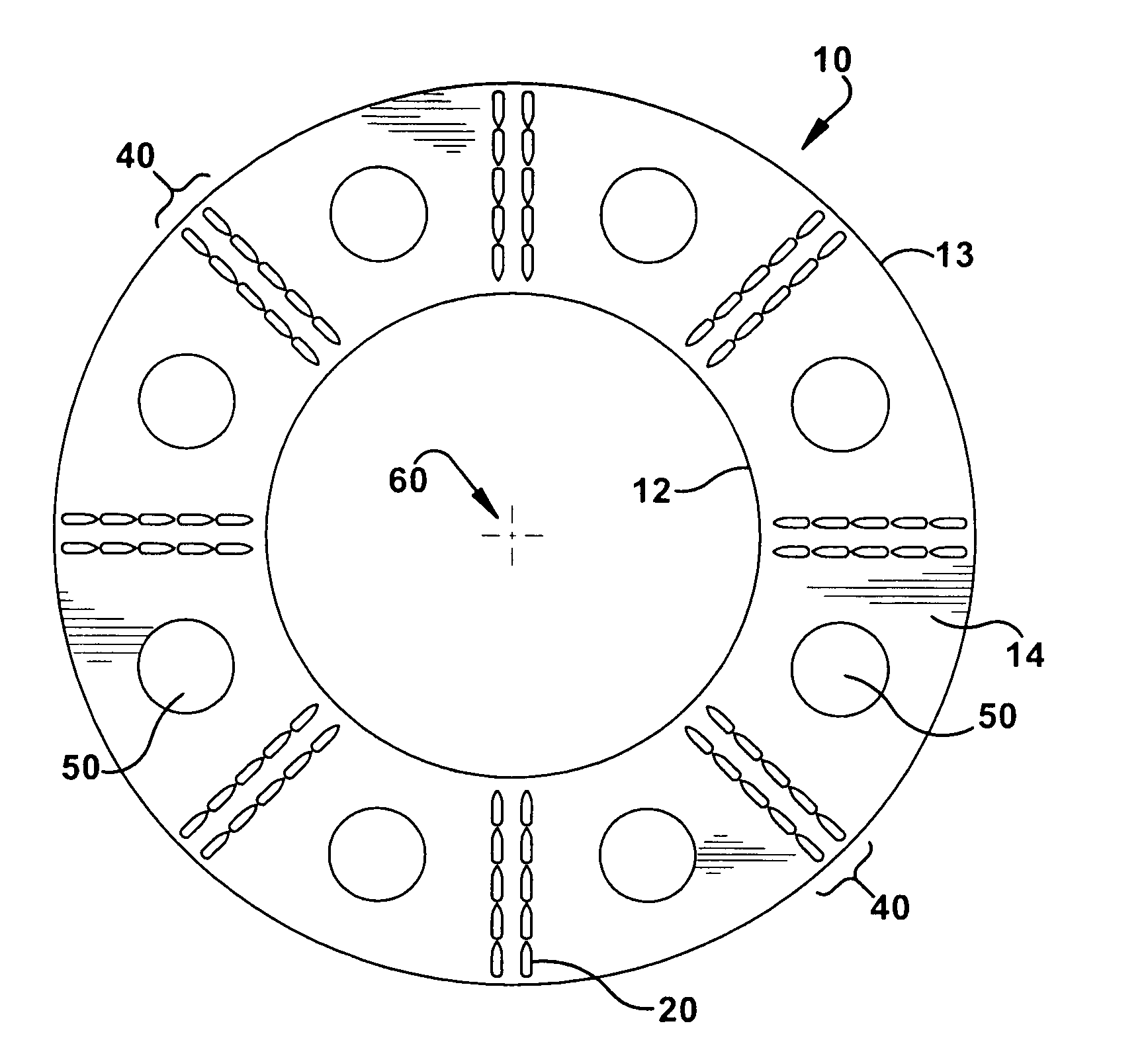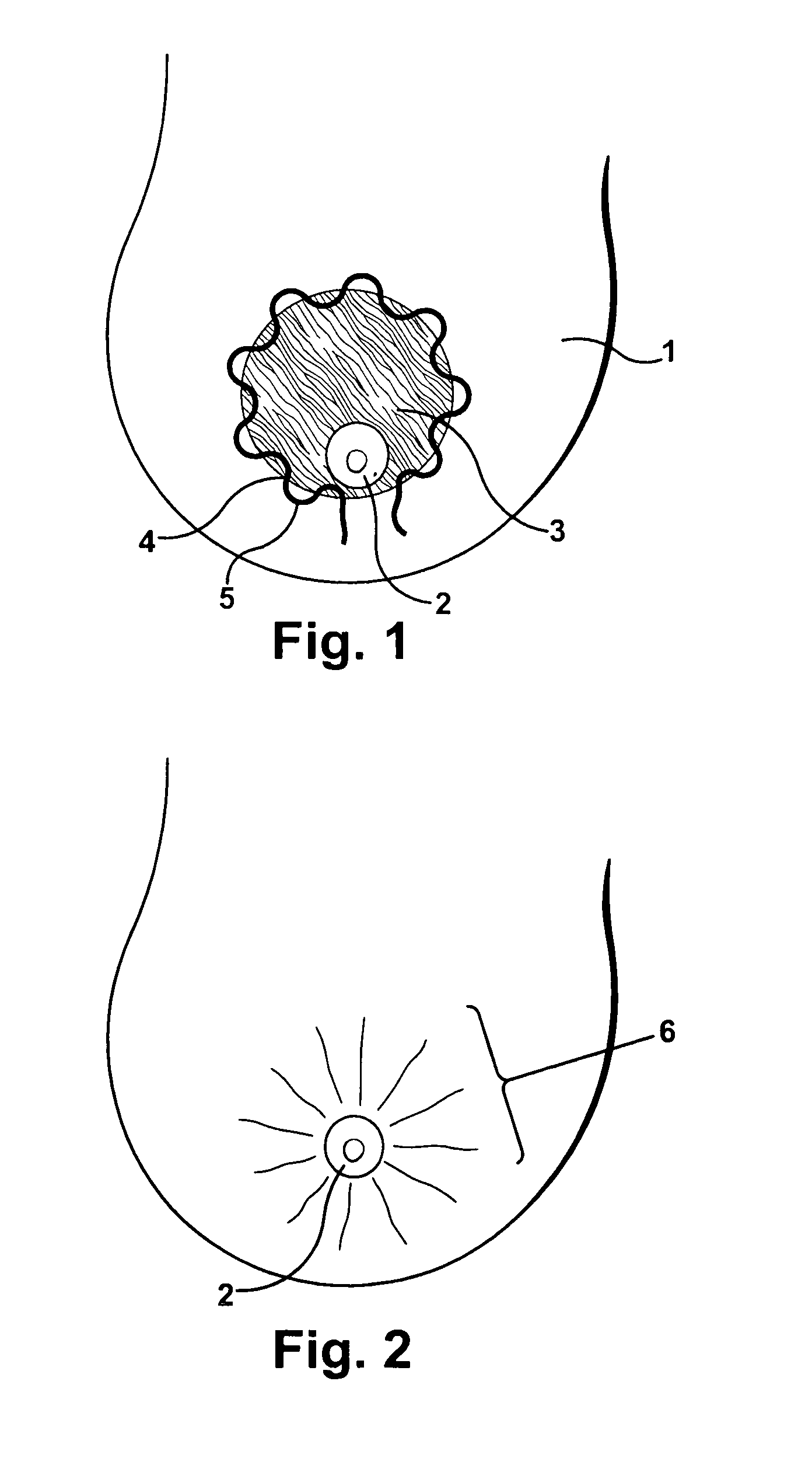Implantable prosthesis for periareolar mastopexy
a technology of periareolar and implantable prostheses, which is applied in the direction of prosthesis, rigid containers, transportation and packaging, etc., can solve the problems of areolar spread, inability to palpable pursestring sutures, and flattening of breasts, and achieves less palpability and not palpable through the skin
- Summary
- Abstract
- Description
- Claims
- Application Information
AI Technical Summary
Benefits of technology
Problems solved by technology
Method used
Image
Examples
first embodiment
Amongst the various embodiments of the present invention described herein, analogous or similar elements are assigned common reference numerals. the implantable prosthesis of the present invention is shown in FIGS. 3 and 4 as comprising prosthesis 10, having an annular, or donut-like disc configuration. Prosthesis 10, preferably constructed of a prosthetic mesh material 11, includes inner aperture 12, outer edge 13, top surface 14 and bottom surface 15. As best seen in FIG. 4, prosthesis 10 is preferably of a relatively thin construction, to facilitate the drawing of skin surrounding the excised periareolar region over the prosthesis, as well as to reduce the risk of the prosthesis being palpable through the skin.
second embodiment
the implantable prosthesis of the present invention is shown in FIG. 5. In this embodiment, prosthesis 10 is slightly frusto-conical in shape, being formed in the shape of a conical frustum. The slightly conical shape of this embodiment serves to minimize the flattening of the breast that can occur, particularly proximate the apex of the areola, as may occur following conventional periareolar mastopexy. In this embodiment, and as is shown in FIG. 5, top surface 14 serves as the outer surface of the conical prosthesis, and bottom surface 15 serves as the inner surface of the conical prosthesis.
The mesh material of the present implantable prosthesis may be constructed of a polypropylene mesh having pore size and density configured to promote in growth of the surrounding tissue upon placement of the implantable prosthesis within the patient. The polypropylene mesh may be covered or coated with polytetrafluoroethylene, silicone, or another suitable chemically inert material.
Alternativel...
third embodiment
the implantable prosthesis of the present invention is shown in FIGS. 6 and 7 as comprising prosthesis 10, again having an annular, or donut-like disc configuration. As best seen in FIG. 7, prosthesis 10 is preferably of a relatively thin construction, to facilitate the drawing of skin surrounding the excised periareolar region over the prosthesis, as well as to reduce the risk of the prosthesis being palpable through the skin.
Moreover, in this embodiment, prosthesis 10 further includes a plurality of projections in the form of teeth, barbs, prongs or tines 20, extending from top surface 14 of the prosthesis. Although teeth 20 are illustrated in FIGS. 6-7 as being generally cylindrical in individual construction, with an angled, substantially sharp pointed end 21 distal from top surface 14, teeth 20 may be configured in any of the various shaped identified in U.S. Pat. No. 6,485,503, the entire contents of which are hereby incorporated by reference. In this embodiment, teeth 20 are ...
PUM
| Property | Measurement | Unit |
|---|---|---|
| angle | aaaaa | aaaaa |
| diameter | aaaaa | aaaaa |
| length | aaaaa | aaaaa |
Abstract
Description
Claims
Application Information
 Login to View More
Login to View More - R&D
- Intellectual Property
- Life Sciences
- Materials
- Tech Scout
- Unparalleled Data Quality
- Higher Quality Content
- 60% Fewer Hallucinations
Browse by: Latest US Patents, China's latest patents, Technical Efficacy Thesaurus, Application Domain, Technology Topic, Popular Technical Reports.
© 2025 PatSnap. All rights reserved.Legal|Privacy policy|Modern Slavery Act Transparency Statement|Sitemap|About US| Contact US: help@patsnap.com



